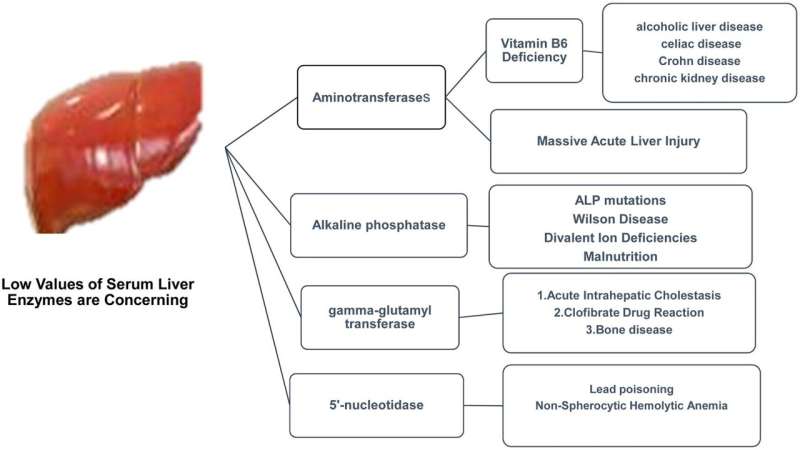This article has been reviewed according to Science X's editorial process and policies. Editors have highlighted the following attributes while ensuring the content's credibility:
fact-checked
proofread
Review focuses on diseases associated with subnormal serum liver enzyme levels

Liver diseases are commonly diagnosed using serum enzyme assays, particularly for aspartate aminotransferase (AST), alanine aminotransferase (ALT), alkaline phosphatase (ALP), gamma-glutamyl transpeptidase (GGT), and 5'-nucleotidase (5'-NT).
While elevated levels of these enzymes are typically associated with liver and bile duct injuries, subnormal levels can also indicate various pathologies. A new review consolidates current knowledge on diseases linked with subnormal liver enzyme levels, focusing on their pathogenesis, specificity, and treatment implications.
The study is published in the Journal of Clinical and Translational Hepatology.
Aminotransferases ALT and AST, critical for amino acid metabolism, are mainly found in hepatocytes but also exist in renal, cardiac, and skeletal tissues. ALT is more specific to the liver, while AST is present in both cytoplasm and mitochondria. Subnormal aminotransferase levels can result from deficiencies in pyridoxal 5'-phosphate (PLP, vitamin B6), often seen in conditions such as:
- Vitamin B6 deficiency:
- Alcoholic liver disease: Alcoholics often suffer from PLP deficiency due to poor dietary intake, impaired absorption, and increased excretion of vitamin B6, leading to low aminotransferase activity.
- Celiac disease: Malabsorption in celiac disease patients results in micronutrient deficiencies, including vitamin B6, which is crucial for aminotransferase function.
- Crohn's disease: Similar to celiac disease, Crohn's disease causes significant malabsorption and vitamin B6 deficiency.
- Chronic kidney disease (CKD): CKD patients, especially those undergoing dialysis, often have reduced PLP levels, which correlate with lower aminotransferase levels due to impaired renal function and nutrient metabolism.
- Massive acute liver injury: Extensive hepatocyte loss can lead to insufficient enzyme release, resulting in decreased serum aminotransferase levels.
Alkaline phosphatase (ALP): ALP, a membrane-bound glycoprotein involved in phosphate metabolism, has several isozymes (intestinal, placental, germ-cell, tissue-nonspecific). Subnormal ALP levels are associated with:
- Hypophosphatasia: This rare inherited disorder results in defective bone mineralization due to mutations in the ALPL gene, which encodes the tissue non-specific isoenzyme of ALP. Patients exhibit low serum ALP activity and present with symptoms such as rickets in children and osteomalacia in adults.
- Wilson's disease: An inherited disorder of copper metabolism where copper accumulates in the liver, brain, and other vital organs, leading to liver enzyme abnormalities including low ALP levels.
- Divalent ion deficiencies and malnutrition: Essential cofactors for ALP activity include zinc and magnesium. Deficiencies in these ions, often resulting from poor dietary intake or malabsorption syndromes, can lead to reduced ALP levels. Malnutrition is another significant cause, affecting the overall synthesis and function of enzymes.
Gamma glutamyl transferase (GGT) is important in glutathione metabolism and is a marker for bile duct function. Subnormal levels are noted in:
- Acute intrahepatic cholestasis: This condition, characterized by impaired bile flow within the liver, can lead to decreased production and release of GGT.
- Medication effects (e.g., Clofibrate): Certain drugs, particularly those used in managing lipid disorders, can reduce GGT levels by altering hepatic enzyme synthesis.
- Bone disease: Conditions such as osteoporosis and other metabolic bone diseases can impact GGT levels due to their effects on bone turnover and liver metabolism.
5'-Nucleotidase (5'-NT): This enzyme is involved in nucleotide metabolism. Low levels can indicate:
- Lead poisoning: Lead exposure inhibits 5'-NT activity. Lead interferes with several enzymatic processes, including those involved in heme synthesis and nucleotide metabolism.
- Nonspherocytic hemolytic anemia: Genetic conditions affecting red blood cells can reduce 5'-NT levels. These conditions often involve enzyme deficiencies that impair red blood cell survival and function.
Subnormal serum levels of liver enzymes are clinically significant and can indicate a variety of underlying conditions. Recognizing these patterns can aid in the early diagnosis and management of diseases such as vitamin B6 deficiency, chronic kidney disease, and specific genetic disorders.
Understanding the pathophysiological mechanisms behind these enzyme deficiencies is crucial for developing targeted treatments and improving patient outcomes. The diagnostic approach to patients presenting with subnormal liver enzyme levels should include a thorough clinical history, dietary assessment, and consideration of potential genetic and acquired conditions.
This comprehensive understanding will facilitate more effective patient care and treatment strategies.
More information: Elham M. Youssef et al, Subnormal Serum Liver Enzyme Levels: A Review of Pathophysiology and Clinical Significance, Journal of Clinical and Translational Hepatology (2024). DOI: 10.14218/JCTH.2023.00446




















